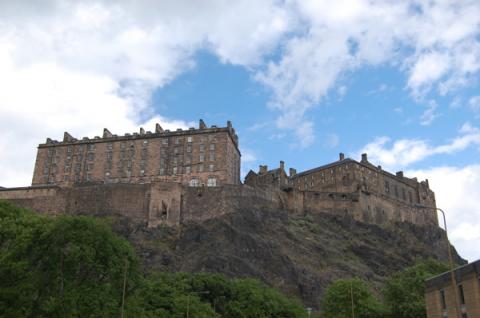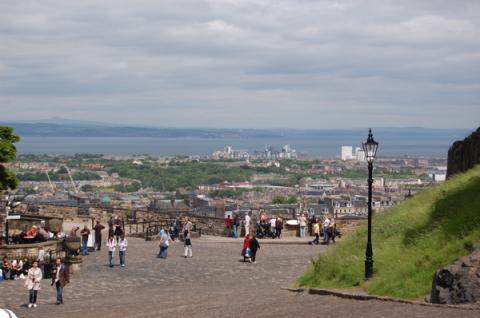
Scale this: Edinburgh Castle's position atop a volcanic rock in the center of the city has protected it through the ages.
Edinburgh is one of the oldest thriving cities in the world, but it has an historical pathology that has forced the new upon the old over many centuries. From the Romans on, everyone seemed to want the city. The city has played offense and defense and, over time, defense has won.
The construction cranes I see all around town bring a tear to an old Otis Elevator Company man like me. Old hospitals and other commercial buildings a century or older are being converted into apartments to meet the demands of a population that can make more of a go of it in a service economy than an agrarian one. For an old city, Edinburghians on the streets skew toward the young end. The cafes and pubs are filled throughout the day with what appear to be young office workers, students or pre-mature pensioners. Nice work if you can get it.
Reinvention is in the lifeblood of the city. We had a splendid tour of Edinburgh Castle yesterday; it dominates the skyline of the town and offers panoramic views across the Firth of Forth to Fife (but not quite as far as St. Andrews) and to the city below. The original Castle was built before years had quadruple digits in them - some evidence says earliest occupation was 900 B.C. - but was lost to the dreaded English in 1296. When the Scots finally recaptured it in 1314, King Robert The Bruce vowed never to let it fall into English hands again. All that remains of that Castle is the tiny St. Margaret's chapel, capacity 20 souls, which is the oldest remaining building in Edinburgh. David II ordered the Castle rebuilt in the 14th Century.
Andrews) and to the city below. The original Castle was built before years had quadruple digits in them - some evidence says earliest occupation was 900 B.C. - but was lost to the dreaded English in 1296. When the Scots finally recaptured it in 1314, King Robert The Bruce vowed never to let it fall into English hands again. All that remains of that Castle is the tiny St. Margaret's chapel, capacity 20 souls, which is the oldest remaining building in Edinburgh. David II ordered the Castle rebuilt in the 14th Century.
When Queen Victoria visited the Castle for the first time in the late 19th Century, she didn't like one of the towers at the entrance; "Off with its head" she declared, and the tower's top was shaved off and rebuilt to her specifications.
We did one other "tourist" thing yesterday, an hour below the streets of Edinburgh, in a place called Mary King's Close. A "close" is a narrow alleyway with residences lining both sides. In the 1700s, the city decided to build a merchant exchange directly on top of an area of tenements composed of four closes, including one named for the most successful merchant on the street, Mary King.
The tour was a major disappointment and not worth the $50 we paid for four. The tour guide was unpracticed and unschooled, or so it seemed. He had memorized his lines and not permitting of question time (the few that were barked out at him were met with more than perfunctory responses). Worse, he dwelled way too long on the unsanitary conditions of medieval Edinburgh life, returning to graphic descriptions time and time again. It was as gross as it was misplaced, and I needed a shower after the tour, and not just because the underground was a bit dank. The ghost stories, advertised as ghoulish, were not nearly as scary as the repeated references to the raw sewage of Medieval times.
Edinburgh is a great walking city, and of course you can fuel your journey by stopping for a pint in one of the burgh's scores of pubs. They are every two blocks or so, and cover two or three corners at some intersections. The weather has been splendid and everyone, it seems, takes their pints outside to the sidewalks. We finished our day with a walk around Edinburgh University, one of the oldest in the world, and a nice dinner at B'est, which might be a little pricey for most university students but not by much. The two-course "pre-theater" dinner was about $20 and the four course about $30 (that adds dessert). I had my first experience with haggis, Scotland's national dish, a mélange of chopped up organ meats and oats boiled in some animal's stomach. It wasn't bad, although like many restaurants in the city, the Scots are modernizing the dish (this one was molded and placed atop a red wine reduction sauce). I would say the taste was somewhere between meat loaf and Quaker Oats and contributed the better aspects of both. It went splendidly with a reasonably priced bottle of rose wine from Australia.
After eight miles of walking the last two days, we opted for the tour buses today. More later...

The views from Edinburgh Castle are spectacular, and on a clear day you can see Fife to the north, although not quite so far as St. Andrews.



